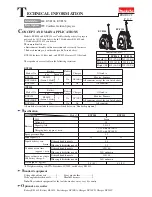
16
308152
Operation/Maintenance
(HYDRAULIC-POWERED PUMPS)
Flush the Pump Before First Use
The pump is tested with lightweight oil, which is left in
to protect the pump parts. If the fluid you are using
may be contaminated by the oil, flush it out with a
compatible solvent. See Flushing on page 17.
Starting and Adjusting the Pump
1.
Refer to the Typical Installation on page 10. Con-
nect the suction kit (T) to the pump’s fluid inlet,
and place the tube into the fluid supply.
2.
Check the hydraulic fluid level before each use,
and add fluid as necessary.
3.
Make certain that the supply line shutoff valve (U)
and the return line shutoff valve (V) are closed.
4.
Start the hydraulic power supply.
5.
Hold a metal part of the gun (S) firmly to the side
of a grounded metal pail and hold the trigger open.
6.
Open the return line shutoff valve (V) first, then
slowly open the supply line shutoff valve (U).
7.
Cycle the pump slowly until all air is pushed out
and the pump and hoses are fully primed.
8.
Release the gun trigger and lock the trigger safety.
The pump should stall against pressure.
WARNING
SKIN INJECTION HAZARD
To reduce the risk of fluid injection, do not use your
hand or fingers to cover the bleed hole on the un-
derside of the bleeder valve body (34) when prim-
ing the pump. Use a crescent wrench to open and
close the bleeder plug (35). Keep your hands away
from the bleed hole.
9.
If the pump fails to prime properly, open the bleed-
er valve plug (35) slightly. Use the bleed hole on
the underside of the valve body (34) as a priming
valve until the fluid appears at the hole. See Fig. 5.
Close the plug (35).
NOTE: When changing fluid containers with the hose
and gun already primed, open the bleeder valve plug
(35) to help prime the pump and vent air before it
enters the hose. Close the plug when all air is elimi-
nated.
CAUTION
Do not allow the pump to run dry. It will quickly
accelerate to a high speed, causing damage. If the
pump is running too fast, stop it immediately and
check the fluid supply. If the container is empty and
air has been pumped into the lines, refill the contain-
er and prime the pump and the lines, or flush and
leave it filled with a compatible solvent. Eliminate all
air from the fluid system.
10. With the pump and lines primed, and with ade-
quate hydraulic volume supplied, the pump will
start and stop as you open and close the gun. In a
circulating system, the pump will speed up or slow
down on demand, until the hydraulic power supply
is shut off.
11. Use the fluid pressure gauge (F) and flow control
valve (G) to control the pump speed and the fluid
outlet pressure. Always use the lowest hydraulic
flow and pressure necessary to get the desired
results. Higher pressures cause premature tip/noz-
zle and pump wear.
WARNING
COMPONENT RUPTURE HAZARD
To reduce the risk of overpressurizing
your system, which could cause compo-
nent rupture and serious injury, never
exceed 10.5 MPa, 105 bar (1500 psi) Maximum
Hydraulic Input Pressure to the pump, 14.0 MPa,
140 bar (2000 psi) Maximum Fluid Working Pres-
sure (see the Technical Data on pages 42–43).
To prevent overpressurizing the hydraulic motor or
its seals, always shut off the supply line valve (U)
first, then shut off the return line valve (V).
CAUTION
Do not allow the hydraulic oil temperature to exceed
54
_
C (130
_
F). The pump seals will wear faster and
leakage may occur if the pump is operated at higher
oil temperatures.
Содержание Dura-Flo 2400
Страница 6: ...6 308152 Notes ...
Страница 12: ...12 308152 Notes ...
















































